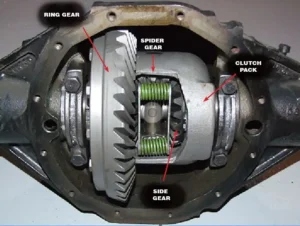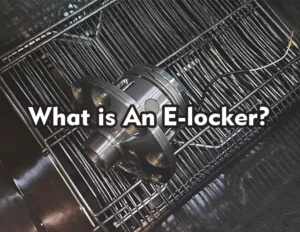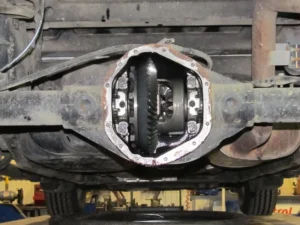Locking differentials are one of the most critical upgrades for serious off-road enthusiasts. Whether you’re tackling rock gardens, muddy trails, or snow-covered terrain, a locker can make the difference between conquering the obstacle or calling for a tow.
Two of the most common options in the off-road world are E-Lockers (electronic lockers) and Air-Lockers (pneumatic lockers). Both are selectable lockers that allow the driver to manually engage or disengage the locking mechanism, turning an open differential into a fully locked axle. But which one is the better choice?
To answer that question, we analyzed real-world feedback from experienced users on Reddit, combined it with engineering insights, and explored the long-term reliability, engagement mechanisms, and installation complexities of both systems.
How Lockers Work?
Before diving into pros and cons, let’s briefly review how lockers work.
In a standard open differential, torque is split between wheels, but when one wheel loses traction (like when it’s in the air or on ice), it spins freely, and the other wheel gets little to no power.
A locking differential solves this problem by mechanically linking the two wheels on an axle, forcing them to rotate at the same speed. This ensures that even if one wheel has no traction, the other still receives torque.
What Is an E-Locker?
An E-Locker uses an electric mechanism (usually an electromagnet or motor) to engage a locking gear or pin inside the differential.

Types of E-Lockers
Electromagnetic Style (e.g., Eaton/Harrop):
- Uses a coil to activate a cam that pushes out locking pins.
- All components are enclosed in the diff housing.
- Common in aftermarket and OEM applications.
Motor-Driven Collar Style (Toyota, Ford OEM):
- An electric motor slides a locking collar to engage the gears.
- Very durable but external motor placement can be exposed to elements.
Advantages:
- No need for a compressor, air lines, or solenoids.
- Easier to install—especially for DIY users.
- Minimal maintenance compared to pneumatic systems.
- Generally reliable in most weather and trail conditions.
Drawbacks:
- Some models (like older Eaton versions) require partial wheel rotation to lock.
- Electric motor can be affected by mud, water, or heat.
- A wiring failure or poor electrical connection can prevent engagement.
What Is an Air-Locker?

An Air-Locker, popularized by brands like ARB, uses compressed air to move a locking collar inside the differential. A dash-mounted switch triggers a solenoid that opens airflow from a compressor to the axle.
Advantages:
- Instant engagement regardless of wheel position.
- Strong, mechanical lock that performs well under extreme torque.
- Field-tested in hardcore off-road environments.
- Dual-use compressor can inflate tires, run air tools, etc.
Drawbacks:
- Complex system: compressor, solenoids, air lines—all potential failure points.
- Requires careful routing and sealing to prevent leaks or water damage.
- More expensive and labor-intensive to install.
- Takes longer to troubleshoot in the field if something goes wrong.
Feedback from Reddit Off-Roaders
The Reddit off-road community brings years of hands-on trail experience. Here are some insightful quotes:
Engagement Reliability
“Some e-lockers need the tire to make a full rotation before they engage. That’s a problem if you’re stuck and can’t move.”
“My air lockers activate the moment I hit the switch—no wheel movement required.”
Air-lockers shine in rock crawling or steep climbs where you’re not moving, and immediate engagement is critical. E-lockers may delay or fail to lock unless there’s tire rotation.
Maintenance and Durability
“Air systems leak. Every group run, there’s someone with a busted line or a compressor that won’t fire up.”
“I’ve broken U-joints and chromoly shafts, but my Eaton e-locker is still holding strong.”
E-lockers tend to survive wear-and-tear better simply because they have fewer parts exposed to the environment. Air systems are great when new, but long-term reliability suffers without proper upkeep.
Installation Experience
“No room for a compressor. I chose e-lockers because I already have an engine-driven one and didn’t want to add another.”
“Wiring e-lockers was easier than routing air lines. No drilling through the cab or firewall.”
If you’re doing the install yourself, E-lockers are far simpler. Air-lockers require mounting the compressor, running air lines, wiring solenoids, and more.
Road vs Off-Road Driving Behavior
While both systems are selectable, E-lockers (especially those with internal electronics) tend to unlock smoothly when disengaged, resulting in better on-road behavior. Air-lockers are equally smooth when off, but failure in the air system could cause unwanted engagement or no engagement at all.
For multi-use vehicles that go from city to trail, E-lockers offer fewer headaches.
Which Locker Should You Choose?
It all depends on your driving style, budget, and technical ability.
Go with E-Lockers if:
- You want a clean, low-maintenance setup.
- You don’t want to mess with air lines or compressors.
- Your vehicle is a daily driver + trail rig.
- You’re doing the installation yourself.
Go with Air-Lockers if:
- You’re a serious off-roader who tackles extreme trails regularly.
- You need immediate, full locking at a standstill.
- You already have an onboard air system.
- You’re building a rock crawler or expedition vehicle.
Conclusion
Both E-lockers and Air-lockers are excellent technologies, each with their strengths. What matters most is matching the right system to your needs, build goals, and wrenching comfort level.
At XJXPARTS, we offer a full lineup of locking differentials, from Torsen-style LSDs to fully selectable lockers compatible with Jeep, Toyota, Ford, and more. Whether you’re upgrading a weekend warrior or building a dedicated off-road beast, our team is here to help you choose the right setup.
Need help? Contact us now.



